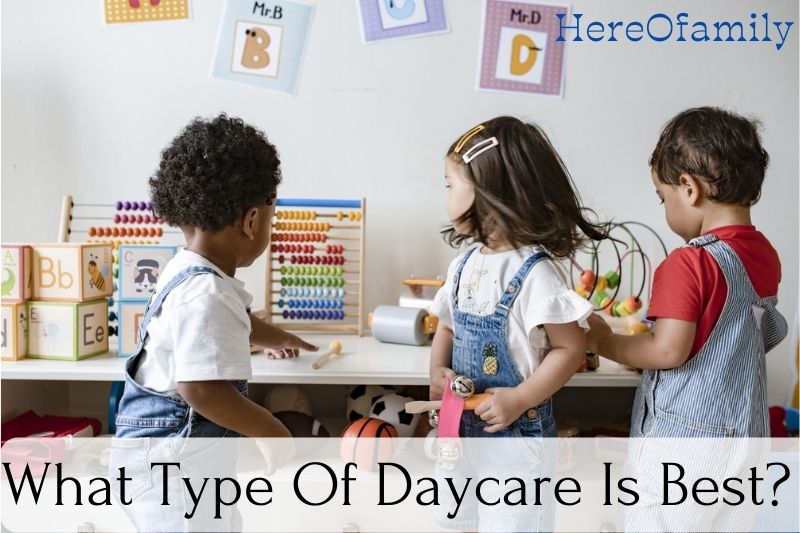- No Voice
If you’re a working parent, you’re likely to need child care. But what type of daycare is best? There are many different choices, and it can be challenging to decide which one is best for your family.
Some factors to consider include the age of your child, your budget, and your schedule. HereOfamily has gathered up some tips when choosing to help you decide which one is best for your family.
Contents
- 1 Types Of Daycare Facilities
- 2 Different Types Of Child Care
- 3 Tips for Choosing Child Care
- 3.1 Stellar Reviews
- 3.2 2. Take a look down.
- 3.3 3. Make A Commitment Request
- 3.4 4. Conduct A Policy Audit
- 3.5 5. Pay A Visit And Take A Look Around
- 3.6 6. Curriculum or Timetable
- 3.7 7. Qualified Caregivers
- 3.8 8. Continue To Speak
- 3.9 9. Resolve The Issue As Soon As Possible
- 3.10 10. Trust Your Instincts
- 3.11 11. Be Flexible And Adaptable
- 4 Conclusion
Types Of Daycare Facilities
A daycare center is where parents send their children off for the day, usually for the entire day, alongside other children of various ages. There are a few options available to you:
Group daycare: These facilities are state-licensed and usually operate the same way as a school, with children of various ages being cared for in groups. Some of these are managed by the businesses themselves.

In-home daycare: This type of child care is run out of the provider’s home, typically while caring for her children. Because not all states require in-home daycare providers to be licensed, make sure you learn about the regulations before entrusting your child to them (or while researching your options).
Different Types Of Child Care
1. A typical Daycare Facility
During regular working hours, most childcare centers provide child care. Many offer half-day or full-day childcare for children and meals and field trips. Daycare centers typically bill families monthly rather than hourly, and they provide a controlled routine for big groups of children.
Daycare centers are primarily self-contained enterprises, although they can also be found in religious institutions, schools, and community centers.
2. Daycare In Your Own House
Compared to traditional daycare facilities, licensed in-home daycare centers frequently provide child care in a home setting with fewer children. In-home daycares may also be less expensive.
In-home daycare centers that are licensed are often expected to offer age-appropriate activities, satisfy safety regulations, and provide child care training to caregivers.
3. Nanny
Nannies provide individualized in-home care for families. They frequently work full-time hours and are employees of the family with whom they work. Typically, nannies are paid by the hour, with an agreed-upon schedule beforehand. Nannies provide flexible and personalized care, but they can be more expensive than other child care options.

A shared nanny is comparable to a typical nanny; however, instead of caring for one family at a time, a shared nanny will look after two families simultaneously. Families might save money by hiring a single nanny to care for all of their children at the same time. This is frequently done in one of the families’ homes and provides social interaction for the children and lower expenses than hiring a full-time nanny.
5. Au Pair Placement
Au pairs are foreign child care providers who live with the families they care for. Parents pay accommodation and board and a stipend to au pairs, which provides child care to families. Au pairs provide families with the flexibility of live-in child care while also providing children with consistent caregivers who frequently become like family members.
6. Hire A Babysitter
A babysitter is someone who looks after children on an hourly basis. They are frequently part-time carers who offer care as needed.
Winnie offers advice on how to hire a babysitter.
7. Relative Assistance
While parents are at work, relatives or friends may step in to help with child care. Regular care from known and trusted people can help children, and relatives and friends are often able to provide flexible care. The amount paid varies based on the situation and the relationship.

8. Preschool
Preschool is available to children aged 2 to 5. Preschools are similar to childcare centers in that they provide children with age-appropriate learning environments. They usually charge every month and allow children to interact with other preschoolers while learning in a semi-structured atmosphere. On weekdays, several preschools provide full-day care.
Tips for Choosing Child Care
Stellar Reviews
Every good daycare will have a good reputation and positive feedback from prior or current parents.
This doesn’t have to be limited to the ones you’ll find online (though you should check those!). Request a list of names and phone numbers of parents you may call for recommendations from the daycare, or ask your friends and family which local center they like.
Take note of any patterns, excellent or poor, as you browse through the evaluations. “No provider is flawless,” says Traci Sanders, author of Right at Home: A Parent’s Guide to Choosing Quality Child Care. “But if the same type of complaints keeps coming in, something isn’t right.”
If you must go online, don’t overlook social media. According to Ziverts, “many daycare providers have Facebook sites.” “Read what they’re saying on social media, and pay attention to what their parents are saying. When parents are involved, it’s a hallmark of a reputable daycare provider.”
2. Take a look down.
Pay attention to how the staff interacts with the children when visiting a possible site. Ideally, a caregiver should be on the floor with the children or holding one in her lap. To thrive in their early years, newborns require tight, loving, engaging interactions with adults.
That’s why it’s critical for newborns’ initial caregivers to be warm and responsive and for infants and older babies to enjoy enough one-on-one time, even in group care. (While local states choose staffing ratios for childcare centers, the American Academy of Pediatrics recommends one adult for every three babies under 12 months.)

3. Make A Commitment Request
Babies require care that is constant and predictable. According to Debra K. Shatoff, a family therapist in private practice in St. Louis, it helps them build a solid bond with their caretakers.
If you’re looking for an in-home caregiver, ask for a one-year commitment from the person you’re considering. If you’re thinking about going to a childcare center, find out how long the current caregivers have been there and how much turnover the center typically has.
4. Conduct A Policy Audit
Find out if you have similar parenting philosophies on topics like discipline (do the caregivers use time-outs or scoldings? ); television (is the TV on all day or used sparingly, if at all? ); feeding (what snacks or drinks are provided for older babies? ), and sleeping (do the caregivers offer naps? How do you put a fussy baby to sleep? ); and so on. Inquire about the sick-child policy (What symptoms make a kid unable to attend?).
Inquire about a backup plan if the family daycare provider or in-home caregiver becomes ill and unable to work. The more questions you ask early on, the less likely you will be disappointed later.
5. Pay A Visit And Take A Look Around
While recommendations from other parents or reliable resources are valuable, you must inspect the facility to determine whether it fulfills your needs. Of course, any childcare setting should be kept clean, childproofed, and well-stocked with age-appropriate books and toys.
Other things to think about: Toys with small components (choking hazards) should be kept away from younger babies when larger children share the space. Ideally, infants and babies should have their own space where they will not be overly “liked” by older toddlers.
At first appearance, a room or separate area dedicated only to swings and bouncers may appear enticing, but remember that growing babies require lots of floor time to develop and strengthen their muscles.
If feasible, visit the same centers at different times of the day to get a sense of how the staff interacts with the children and the daily routine.
After you’ve enrolled your child, you might want to drop in unannounced a few times to see how things are going. Your visits will sometimes confirm that the location is perfect for you, and other times they will be a true eye-opener.
6. Curriculum or Timetable
What counts as “excellent,” in this case, will determine what you desire for your child’s dream day.
Do you want them to have a more flexible, child-led schedule that changes frequently? Or do you prefer a more traditional educational setting with a set curriculum? In either case, top-notch childcare will suffice. Also, unless it’s part of the curriculum and age-appropriate, keep television and DVDs to a minimum (or none at all).

“Excellent early care and education programs encourage children to take an interest in the content and their learning. “Knowledgeable teachers balance key learning outcomes and children’s natural interests,” Robertson explains. “Regardless of the type of program you choose for your child, you and his or her teachers can work together to improve their learning experience.
Parents and teachers may help children and prepare them for future success both in and out of the classroom by establishing solid home-school partnerships.”
7. Qualified Caregivers
Check to see if they have the necessary certifications.
What criteria do you use to evaluate the adults in the room? First, double-check that they have the fundamentals in terms of qualification and training. Most should have or be working toward a degree in early childhood development and should have completed at least two years of college. CPR and other emergency methods should also be taught to them.
When it comes to intangibles, merely watching can teach you a lot. Please take note of the teachers’ or caregivers’ body language and how they interact with the children. “Look for teachers who respectfully speak to children at their eye level,”
Robertson advises. “Instead of an authoritative tone, frequent orders, or many no’s, parents, want to hear meaningful talks and polite tone of voice, especially in infant and toddler rooms.”
How comfortable are you with the caretakers, aside from interacting with the children? Are they open, straightforward, and eager to collaborate with you in the care and education of your children?
8. Continue To Speak
You’ll have to rely on what the caregiver tells you about your child’s day until they can speak. Make sure you’re able to converse easily with one another. You should tell the caregiver how your child slept the night before, if he is teething, and if he ate breakfast when you first hand over your child in the morning.
You’ll want to know how many diapers he went through when he napped and if he appeared content. It’s always better to chat with the caregiver face to face. If that isn’t an option, see if there is a convenient time to call, such as during nap time.
9. Resolve The Issue As Soon As Possible
It’s unavoidable that you’ll have disagreements with your caretaker, big and little. Rather than ignoring things until they become out of hand, deal with them immediately away.
Some issues can be settled quickly, while others may necessitate more debate. Whatever the dispute, Deborah Borchers, MD, a pediatrician in private practice in Cincinnati, advises treating the caregiver with respect but not being afraid to speak up.

When dealing with a complex matter, seek out the caregiver’s perspective and listen to her. You have the final say with an in-home caregiver as the parent, but if the caregiver believes she has been heard, she is more likely to cooperate.
Instead of demanding an earlier nap time to make sleep easier, ask your baby’s caregiver if she has any suggestions for changing your baby’s schedule, so he doesn’t become overtired in the evening.
10. Trust Your Instincts
When something doesn’t feel quite right, every parent is aware of it. You might be put off by a center that everyone in town praises, or you might disagree with a sitter who comes highly recommended. If this occurs, keep looking.
Babies deserve and thrive in loving, nurturing environments. Investigate alternate options if something about your scenario doesn’t feel right.
11. Be Flexible And Adaptable
You’re not married to a particular person or scenario, and you can always change things up if things don’t work out. Yes, you want your infant to have a routine, but it doesn’t mean you can’t change things up. Dr. Shatoff reminds out that babies are resilient, and as long as they have a pleasant experience with their new caregiver, they will be alright.
You are still your child’s primary caregiver—the most consistent source of love and support in her life—regardless of your working hours. Your baby will thrive and grow into a happy, healthy child under your care and supervision with the aid of your carefully selected caregivers.
Conclusion
There are a lot of choices when it comes to choosing what type of daycare is best for your family. But ultimately, it all comes down to what your child needs. When you find a daycare that meets your child’s needs, you’ll get the most out of it. So, find a daycare that fits your schedule and meets your child’s needs.
